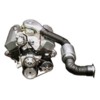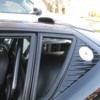-Back to basics
If we’re talking about power potential, we’re really talking about how to increase charge air density. Why? Because it means at a given air fuel ratio you can potentially add more fuel to burn along with that added air and that means more potential power!! Ideal gas law would suggest the increase in density is proportional to the increase in absolute pressure (at constant temperature). It’s also inversely proportional to the increase in absolute temperature (at constant pressure). These are approximations so all you physicists have a cup of copy and settle down. So there are two sources of improved density being discussed in this thread; dynamic pressure (ram air), and air density increases resulting from cooler charge air. So let’s just forget about the practical aspects of harnessing it in a Pantera for a moment and consider (approximations) for what the theoretical potential is for power increases.
As far as increases from dynamic pressure (boost from ram affect), at constant temperature and speeds below 100 mph, you’re probably, well, pissing in the wind fellas. But since dynamic pressure goes as the square of velocity, the discussion can change as you progress up the scale.
So the potential increase in charge air density due to ram affect would be about proportional dynamic pressure increase compared to standard atmospheric pressure (14.7 psi or 29.92 in Hg). So at speed, dynamic pressure, % density increase, you would achieve:
50 mph, .04 psi, .3%
100 mph, .17psi, 1.2%
150 mph, .39psi, 2.6%
200 mph, .69psi, 4.7%
You can play around here. I can’t vouch for the formula or assumptions but it does yield results in the approximately the correct ranges.
http://www.wallaceracing.com/ram-air-calc.phpAre these increases significant? You decide, but in practice, it’s hard to deliver all of this theoretical pressure to the inlet of your induction system.
Now, the other factor, temperature related air density increases, may be more significant for a variety of reasons. If we go back to ideal gas law, at constant pressure, air density is proportional to changes in absolute temperature. For those of us who speak in terms of degrees Fahrenheit, that means the Rankine scale or degrees F + 460. For Celsius guys it’s Kelvin or degrees C + 273. In the case that Will cited in this thread, he indicated that he achieved an 80F drop in charge air temperature (180F to 100F on a 75F day). This is 640R to 560R or (640-560)/640 or 12.5% increase in density. That’s a big deal. I do need to caution that Will didn’t state how he collected the data because if he only measured while the car was standing still, that may not be representative of the improvement he has achieved at different speeds. He’ll have to weigh in on his methodology. But if he is averaging 80F lower inlet temps at all speeds, 12.5% potential power uplift there for the taking is big!
Now let’s get away from theory to reality. As far as the elephant ear and boundary layer discussion, if (and it’s a big if), you can duct air from the ears to the inlet without picking up heat or having pressure drop, you may be able to realize some improvement. I have my doubts. The hose diameter on those ears looks small. What is it? 3.5”-4”? Even though there are two of them, they will create pressure drop which may negate some/all of temp related improvements. This will be exacerbated if they are in the boundary layer, because this will further reduce the inlet pressure at speed because you are drawing from a low pressure zone. But don’t fret guys. For the same reason there is little to be gained from ram air affect, there is likely little to be lost from boundary layer affect. Air filter pressure drop either due to small area or dirty filter is probably comparable to the pressure changes we’re talking here.
Now back to the temperature thing. If a charge air system like Will’s that is roof top actually achieves (sorry Will don’t mean to be a skeptic, it’s my nature) that temperature drop combined with even some Ram affect, that’s kind of exciting. In practice for internal combustion engines, it’s not just the potential benefit in charge density, it’s the fact the charge is then compress before it is ignited. The heat of compression is a stronger function of temperature so reducing inlet temperature can mean more dramatic decreases in compressed temperature in the cylinder, and this means less susceptibility to detonation. If you are a pump gas guy this is of interest because it means you can either run higher compression or more ignition advance if your combo likes it. This is sort of a wild card but can also be significant power increase after tuning. If you have a boosted engine reduced inlet temps (intercooling) are huge because it dictates how much boost can be safely applied.
This subject has sort of been beat to death over the years but most people with street cars have realize 1-6% improvements in power from charge density management, perhaps more when starting with very poorly design systems. In all cases you must be able to tune or have an engine management system that will make the adjustments to take advantage of the potential.
As far as other factors for the Pantera discussion, reducing charge air temperature won’t necessarily mean your engine will run cooler, in fact, probably not because presumably your cooling system can independently maintain engine temperature. If you have a car that lacks sufficient cooling capacity and overheats, it could help potentially provide some marginal help. It’s unlikely it will have any measurable affect on engine compartment or cockpit temperatures. That is driven by the surface area of exhaust and engine and how well the engine compartment is ventilated.
BTW, Rick your mod motor install is one of the nicest I've seen. -Well done.
Best,
K





